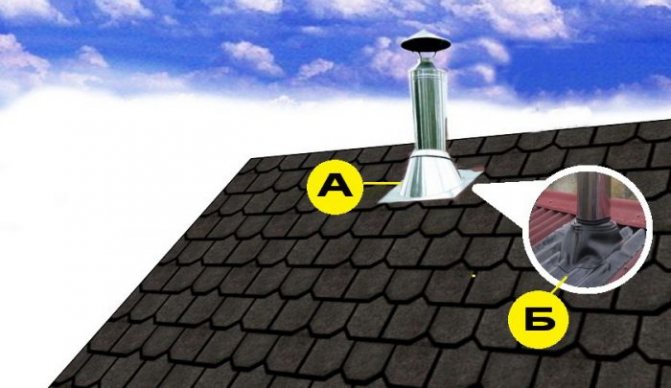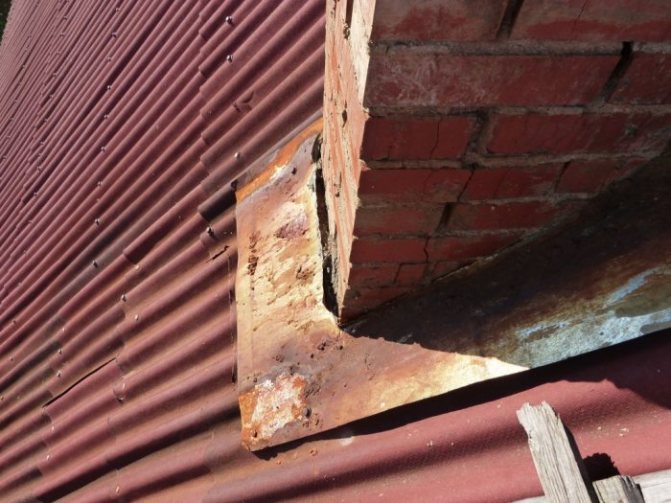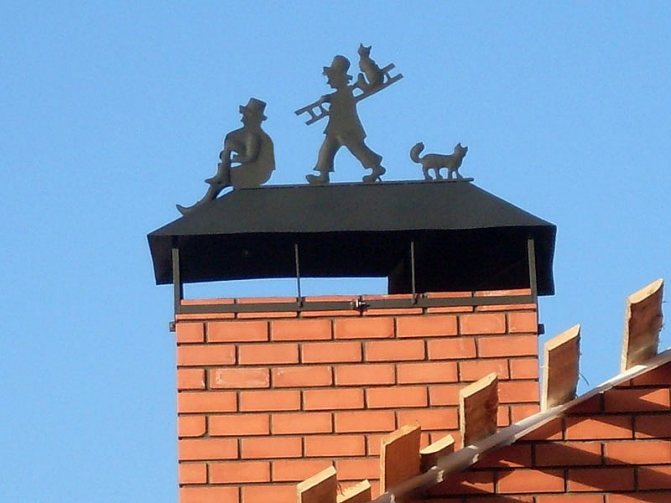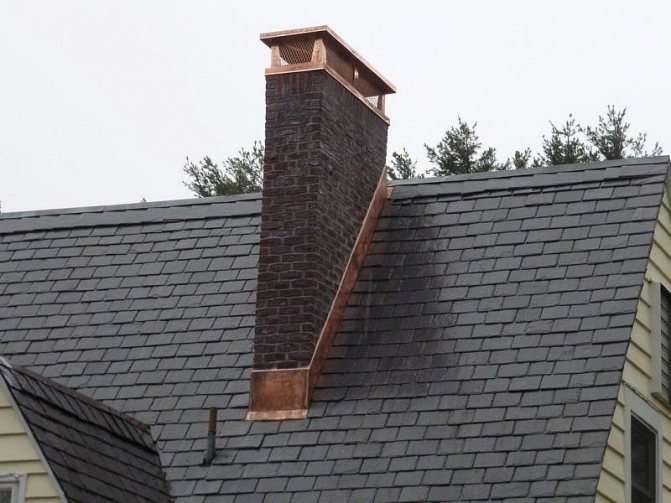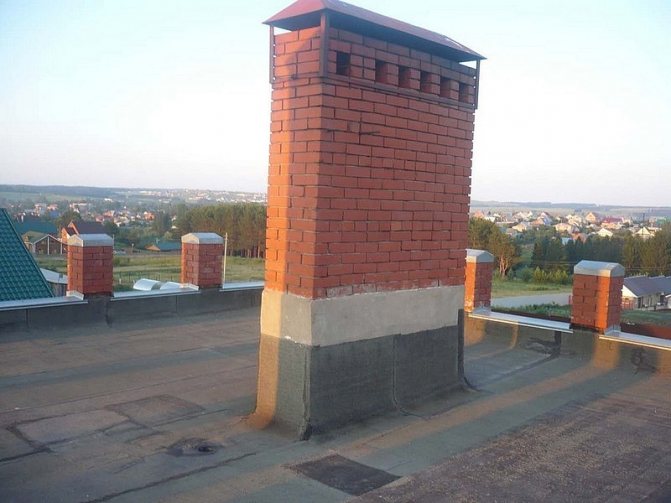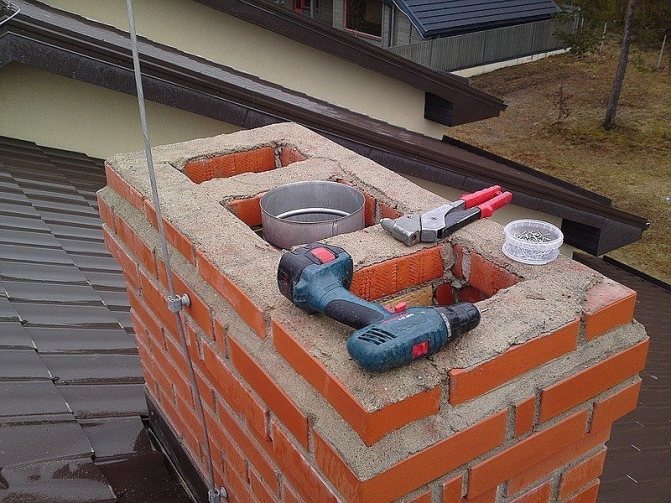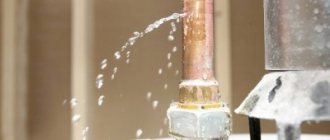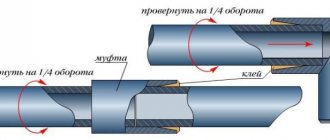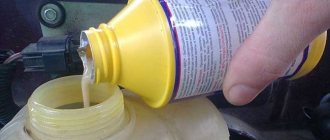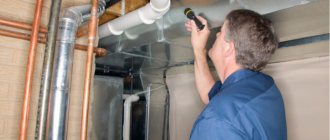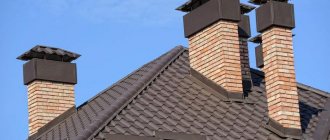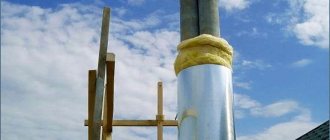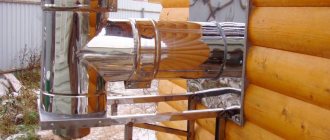If you do not seal the joint
When removing the chimney, a hole is made in the roof. The gap between the coating and the walls of the chimney is sealed with special aprons, collars and seals. You can buy them at any hardware store. These protective elements are easy to make with your own hands.
If you do not seal the seams on the roof in time, the following consequences are possible:
- Increased wear on the roofing material. Water entering the gap enters the inner surface of the roof, which causes deformation of the coating.
- Reduced service life of the building frame. Water, which is poured into the gap between the pipe and the roofing, promotes the gradual decay of the wood. This is fraught with deformation and destruction of the rafters.
- Insulation loses its effectiveness. The heat-insulating materials with which the roof is equipped can quickly lose their properties when wet. If hard heaters are not very susceptible to moisture, then soft ones quickly begin to rot.
- Increased humidity in the attic. Increased dampness causes stale, heavy air. This can negatively affect the interior decoration of the attic.
The way to eliminate the gap between the pipe and the roof depends on its size and type of coating. Also take into account the shape of the chimney. At a distance of less than 5 mm, a heat-resistant sealant is used. If the gap width of 1 cm is exceeded, cement mortar, an apron or a special sealant are used.
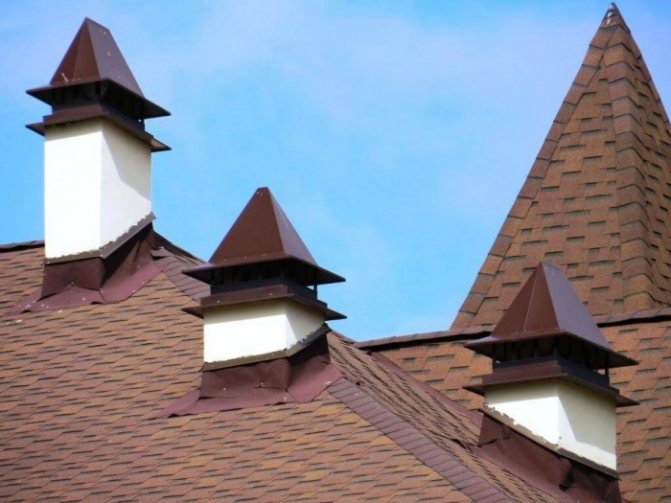
It is necessary to close the gap between the pipe and the roof in order to:
- ensuring the isolation of the attic from atmospheric moisture;
- to improve the efficiency of thermal and waterproofing;
- increasing the service life of the rafter system and the entire roofing structure;
- exclusion of cold bridges.
Sealing the chimney on the roof avoids the destruction of the roof itself.
Features of the choice of places for the outlet of chimneys
In order for the roof to be reliable and moisture-proof, it is important to choose the correct outlet for the chimney or ventilation shaft. This will save time as much as possible, since in this case it will be much easier to seal the pipe on the roof made of corrugated board.
The following sections are considered the most optimal places for organizing the passage:
- On a skate. This is the most practical place to get the pipe out. By making the passage of the chimney through the roof of the corrugated board in this place, snow pockets, condensation will not form and the risk of leaks will be minimized as much as possible. It is important to take into account that such a placement of the passage will lead to a violation of the solidity of the ridge beam. In this case, silicone sealant is used to fill the formed joint. To preserve the external aesthetics, a decorative apron is used.
- Not far from the ridge (50-7 cm). Also a good option is how to make a pipe on the roof from corrugated board. If you remove the chimney at a specified distance from the ridge, this will not violate the integrity of the rafter system. Joint protection is carried out with elastic gaskets and special additional elements.
There is a rule that with a decrease in the level of location on the roof of the outlet for the pipe, the complexity of its sealing increases.
For the organization of the chimney and ventilation of the roof from the corrugated board, rectangular pipes are often used. They are usually built from heat-resistant bricks or special ceramic blocks. To finish the areas where the corrugated board adjoins the chimney, a ready-made shaped product in the form of an apron is usually used. The material for the manufacture of such an apron is usually galvanized steel.After installation, it can be painted to match the roof.
To design a joint with an apron, you will need to perform the following steps:
- Waterproofing and insulation, damaged during the organization of the chimney outlet, are glued to the outer walls of the pipe. To do this, use construction tape.
- The perimeter of the pipe is formed by a shallow groove: the upper abutment bar is placed in it.
- After installing the upper part of the abutment bar in the groove, it is additionally fixed with a heat-resistant silicone sealant.
- When placing the lower part of the apron, an overlap of 10-15 cm is observed.
- Before closing the pipe on the roof from rain, the lower part of the apron is equipped with a tie made of waterproofing film: it serves as protection against leaks.
To organize the passage of the pipe through the roof of the corrugated board, a galvanized steel pipe with a round section can be used. In this case, the sealing of the abutment joints is not very difficult. It is for these purposes that elastic funnel-type penetrations are intended. The materials for their manufacture are usually latex and synthetic rubber. They are usually included with pitched and flat roofs.
The process of sealing a joint using elastic penetration looks like this:
- Selection of flexible penetration suitable for the size.
- Cutting off the narrow section to ensure a tight grip on the pipe.
- Removing the protective umbrella and deflector from the pipe, followed by careful tightening of the elastic penetration. The product must cover the entire pipe section.
- Fixing the base of the penetration to the roof surface is facilitated by the presence of a self-adhesive backing. You can also use silicone sealant or roofing screws.
- At the final stage, a decorative apron is mounted. It looks like a cap and is tinted to match the color of the roof. The apron is designed to protect elastic penetration from solar radiation and mechanical stress.
Elastic penetration sizing is key to ensuring a reliable joint seal. When the product lies loosely on the pipe, it is necessary to additionally use a sealant and a steel clamp. Small diameter passages can break when trying to fit over the chimney.
Decking is a popular roof material. It is distinguished by its durability, strength, resistance to temperature extremes, decay, corrosion and prolonged exposure to ultraviolet radiation. In addition, with the help of corrugated board, you can install the roof quickly and inexpensively. In this case, special attention should be paid to finishing the junction of the chimney to the corrugated board.
Decking is a high-quality and durable roofing material that has good load-bearing capacity, as well as resistance to corrosion and decay. The roof of the house can have not only ventilation holes, but also a chimney. The presence of various holes leads to a violation of the waterproofing of the roofing material, therefore it is extremely important to seal the joints.
If the sealing process is carried out incorrectly, the following problems may arise:
- Leaks. If uninsulated cracks remain during the installation of the roof, this leads to the penetration of moisture into the house, damping the ceiling and walls, and the appearance of fungus.
- Rotting rafters. When moisture gets through the joints, the tree from which the rafters are made rots and collapses.
- Corrosion of corrugated board. The top layer of the corrugated board is covered with an anti-corrosion agent. But its inner side can be damaged by moisture.
- Decreased thermal insulation. When moisture gets in, the roof's ability to protect the house from cold is reduced.
We offer you to familiarize yourself with How to make a ceiling and a roof in a bath
For high-quality sealing of joints, there are various methods and materials for sealing.
The finishing of the joints depends on the choice of the chimney outlet. Therefore, you should think in advance how to bring the pipe through the roof from the corrugated board.The chimney outlet can be located in the following places:
- On a skate. The optimal solution if the roof is made of corrugated board. If you remove the chimney on a ridge, you can almost completely eliminate the risk of condensation, snow pockets, and leaks. In this case, the joint between the roofing material and the chimney must be treated with a sealant, and also additionally sheathed with a decorative apron.
- About 60 cm from the ridge. Installing an exit in such a place is also considered successful. It prevents leaks. Elastic penetrations are used to protect the joint.


The complexity of waterproofing installation depends on the location of the chimney. The lower along the slope is the passage of the pipe through the roof made of corrugated board, the more difficult it is to make waterproofing between the chimney and the roof.
There are several effective methods on how to seal a pipe on a roof made of corrugated board, each of which has a number of advantages and disadvantages. The sealing of the chimney on the roof is most often done with protective aprons and elastic caps.
Elastic cap
For waterproofing circular passages, it is recommended to use an elastic cap. For its production, strong and durable latex is used, which must withstand significant temperature changes and constant exposure to direct sunlight.
The hood is installed in the following sequence:
- The narrow part of the hood must be trimmed so that the latex fits snugly against the aisle.
- Pull the rubber cap over the pipe until it joins the roof.
- Attach the base of the hood to the corrugated board using a self-adhesive base. First, remove the protective layer, and then tightly attach the cap to the roof. The surface of the corrugated board before installing the waterproofing should be thoroughly cleaned of dust and other contaminants.
- The hood is reinforced with self-tapping screws, and the gaps on the roof made of corrugated board are sealed with a sealant.
- For additional protection, an apron is mounted on top. It can be made in different colors, which allows you to match it to the color of the roof.
Mounting the hood is straightforward. The main thing is to purchase this building element of the correct section, depending on the diameter of the chimney opening.
Protective aprons
To protect the chimney, not only rubber caps can be used, but also aprons made of various materials. For waterproofing the chimney with a circular cross section, it is recommended to use protective aprons made of galvanized steel. In this case, the junction of the apron with the roof is additionally protected with a steel clamp, and all the cracks are sealed with a sealant.
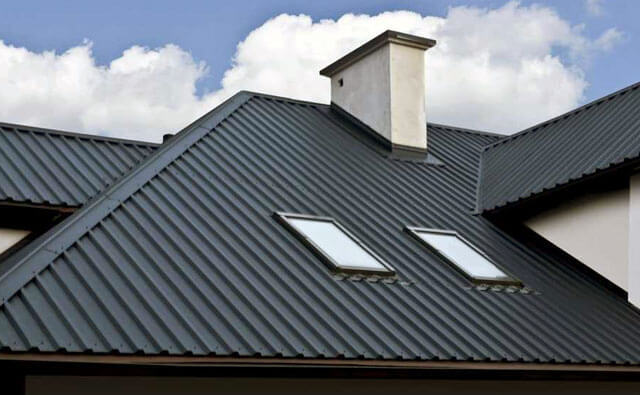

Sealing a rectangular chimney is more difficult. In this case, the apron should consist of several parts. Sealing in this case occurs according to the following scheme:
- Roof waterproofing is attached to the apron with construction tape.
- A shallow groove must be made around the perimeter of the chimney.
- The top edge of the strip must be attached to the groove with a sealant.
- The protective apron consists of four parts. A separate piece is used on each side of the rectangular pipe. The lower part of the apron is tightly attached to the aisle. This must be done with an overlap of 10 cm. To fasten the parts, use special self-tapping screws for the corrugated board.
- It is recommended to place a tie under the bottom apron to prevent leaks.
- The other parts of the chimney sealing should be installed according to the same principle.
Carrying out roof waterproofing from corrugated board is a simple, but mandatory process. It is extremely important to properly seal the joints, as well as to choose the optimal material for the protective aprons.
At the moment, there are many roofing materials on the construction market that are used for high-quality and beautiful roofing. Profiled sheeting, a multi-layer protective building material, has gained wide popularity. When creating a roof, special attention should be paid to sealing the pipe through the roof.
Incorrect installation of the smoke passage and ventilation leads to leaks and leakage of the roof. In this article, the reader will learn how to properly seal a pipe on a roof.
Decking is a high-quality roofing material that has a complex layered structure. Layers are applied to the outer base made of steel sheet:
- zinc;
- additional anti-corrosion;
- primers;
- polymer (polyester);
- assembly protection.
And on the inside, galvanized, primed and corrosion protection are also applied. Thanks to this structure, the corrugated board has excellent bearing capacity, protection from rust, fire and decay. The building material retains its properties over a wide temperature range.
- The passage of these structures can be sealed with bituminous derivatives. Quite often, roll materials are used for this purpose.
- Installation of self-adhesive tape. This material has a foil layer.
- Installation of special aprons made in the form of caps. They are also called roof passages. These devices are simple and reliable. They must be put on a round tube and fastened to the roof lathing.
- On a skate. The most advantageous place for the outlet of pipes is the ridge of the structure. This arrangement excludes the formation of snow pockets, condensation, reduces the likelihood of leaks, however, violates the integrity of the ridge beam. If the chimney or ventilation duct is removed through the ridge, then the joint between them and the roofing material is enough to fill with a silicone-based sealant, and then sheathe it with a decorative apron.
- At a distance of 50-70 cm from the ridge. This arrangement is considered advantageous, since it minimizes the formation of snow pockets and prevents leaks. When removing the chimney at such a distance from the ridge, the rafter structures are not disturbed. To protect the joint between the pipe and the roofing material, elastic penetrations and additional elements are used to assemble the apron.
- Waterproofing and vapor barrier material, which was cut during the removal of the chimney outside, is carefully glued to the outer walls of the pipe using construction tape.
- A shallow groove is made along the perimeter of the pipe for installing the upper abutment bar using an angle grinder.
- The upper edge of the abutment bar is placed in the groove, additionally fixed with a heat-resistant silicone-based sealant.
- The lower part of the apron is placed with an overlap of 10-15 cm; special self-tapping screws for corrugated board are used to secure it.
- A tie is placed under the lower part of the apron - an element made of waterproofing material that prevents the formation of leaks.
- Choose an elastic passage of a suitable size, and then carefully cut the narrow part of the product so that it fits snugly around the chimney.
- It is necessary to remove the protective umbrella or deflectors from the pipe, and then carefully pull the elastic passage over the chimney to the very base.
- The base of the penetration is attached to the roof using a self-adhesive base, silicone sealant or roofing screws.
- Finishing is completed by installing a decorative apron on the chimney in the form of a cap to match the color of the roofing material, which protects the elastic passage from ultraviolet rays, as well as from mechanical damage.
- Leakage. When the pipe is led out through the roof, the presence of uninsulated slots leads to the penetration of water into the house, living quarters, dampness of walls, including bearing ones, the appearance of mold, etc.
- Destruction of rafters. The roof structure consists of wooden rafters.Moisture, getting through the joints, contributes to the decay of the tree and the destruction of the entire structure.
- Corrosion of corrugated board. Despite the fact that the roofing material is protected by anti-corrosion layers, the inner protection is weaker than the outer layer. Corrosion gradually destroys the corrugated board, reduces its protective characteristics and attractive appearance.
- Reducing the level of roof insulation. When water penetrates into the layers of thermal insulation, the latter lose their ability to retain heat and protect from external cold. An insulator loses about 50% of its ability to effectively retain warm air in a residential area.
- on a skate. The advantages of this place: reduces the possibility of leakage, eliminates the formation of condensation. Its downside is that the creation of a pipe will violate the integrity of the ridge girder - a wooden beam at the top of the roof structure;

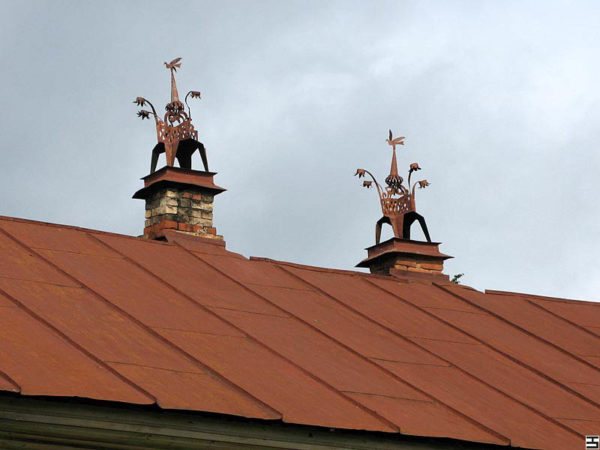
- near the ridge (about half a meter). It is also an advantageous location as it waterproofs the roof well. In addition, unlike the first method, the equipment of the passage at a distance of 50 cm (plus or minus 20 cm) from the ridge will not disturb the roof rafter system.

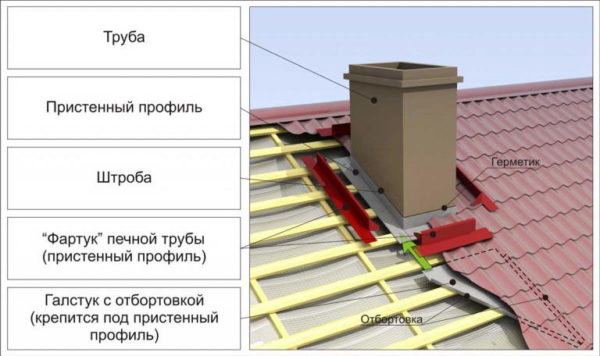
We suggest that you familiarize yourself with How to fix a wooden floor to logs
Flash Master
Materials (edit)
The seam between the pipe and the roof can be sealed with silicone, acrylic, polyurethane and bituminous sealants. Special sealing tapes are also successfully used. Each of these types has its own advantages and areas of application.
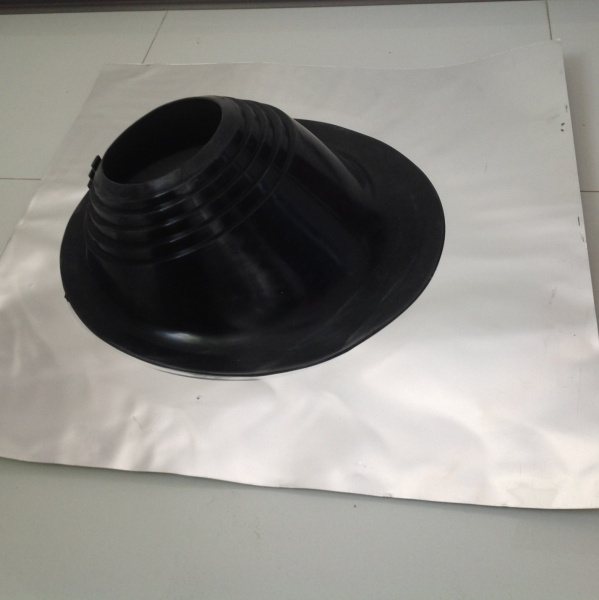

Silicone sealant has become a kind of versatile material in construction. It is used both for working with the roof and for sealing window openings. Silicone sealant is often used when working with glass and wood. They are often treated with a gap around the chimney of a pipe on the roof. The material does not lose its properties with prolonged exposure to ultraviolet radiation and high temperatures. To seal the joints of roofing material, there is a special subspecies of it - roofing sealant.
Acrylic sealant is most commonly used to seal crevices in walls and floors. Also, acrylic compounds are used to repair windows. For outdoor work, it is rarely used - it is not elastic enough.
Polyurethane, unlike acrylic, is used almost everywhere for outdoor work. They are glued to metal, concrete, wood, stone. For minor repairs, the roof is ideal.
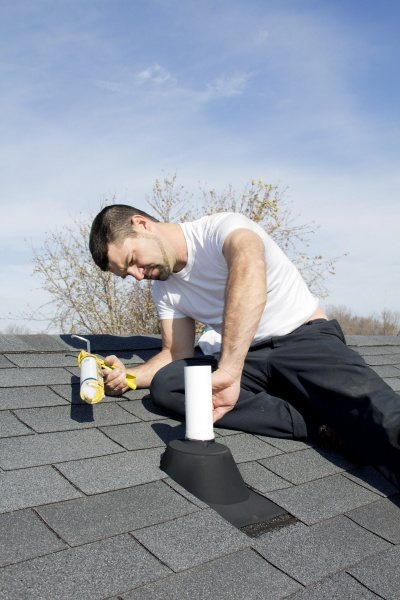

Bituminous mortars are ideally combined with roofing work. They are resistant to precipitation, temperature extremes, and chemical solvents. The only drawback of such a sealant is its toxicity. For this reason, no internal work is carried out with him. They are ideal for sealing a roof chimney.
The main advantages of bitumen:
- super-durability;
- low cost;
- elasticity;
- the possibility of staining;
- high moisture resistance;
- high level of adhesion to dry and wet surfaces.
There are several subspecies of bituminous mixtures that are specially designed for roofing. They are able to ensure complete tightness of the gap to be treated between the pipe and the roof covering.
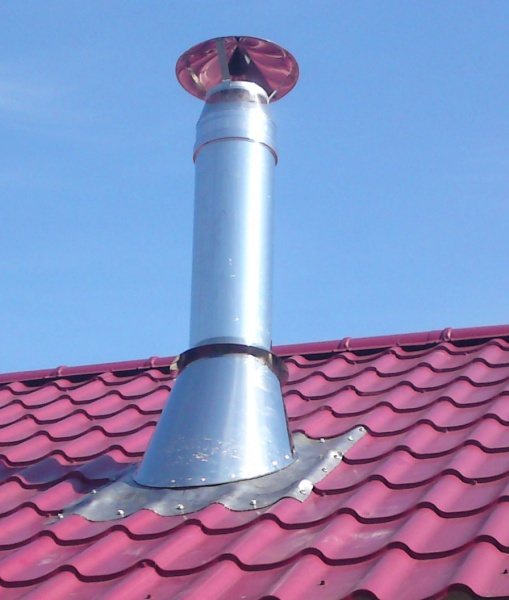

How to seal a rectangular pipe passage - sealing
For the organization of the chimney and ventilation, rectangular pipes are often used. They are usually built from heat-resistant bricks or special ceramic blocks. To finish the areas where the corrugated board adjoins the chimney, a ready-made shaped product in the form of an apron is usually used. The material for the manufacture of such an apron is usually galvanized steel. After installation, it can be painted to match the roof.
To design a joint with an apron, you will need to perform the following steps:
- Waterproofing and insulation, damaged during the organization of the chimney outlet, are glued to the outer walls of the pipe.To do this, use construction tape.
- The perimeter of the pipe is formed by a shallow groove: the upper abutment bar is placed in it.
- After installing the upper part of the abutment bar in the groove, it is additionally fixed with a heat-resistant silicone sealant.
- When placing the lower part of the apron, an overlap of 10-15 cm is observed.
- Before closing the pipe on the roof from rain, the lower part of the apron is equipped with a tie made of waterproofing film: it serves as protection against leaks.
It is best that the additional elements for the decoration of the area of abutment of the roof and the rectangular chimney are made of the same material as the roof covering. Manufacturers of profiled sheets specifically for these purposes produce protective aprons.
Tape sealant
Tape sealant is a hard material. Many builders consider it to be the most profitable option for roof sealing. Material Features:
- it is based on butyl rubber;
- the sealant tape is highly resistant to ultraviolet and high temperatures;
- it has high adhesiveness, due to which it is easy to install;
- ideal for sealing joints between chimney and roofing.
The tape has an aluminum coating, which increases the life of the sealant for outdoor use. The tape is easy to install and operate. The average service life of the product is 10 years. Due to its wide range of colors, the tape can be used for sealing various roofing coverings. The sealant has excellent adhesion to a variety of surfaces. The tape is used when it is necessary to seal wooden, plastic, metal surfaces. The tape is also successfully used for sealing translucent roofs.
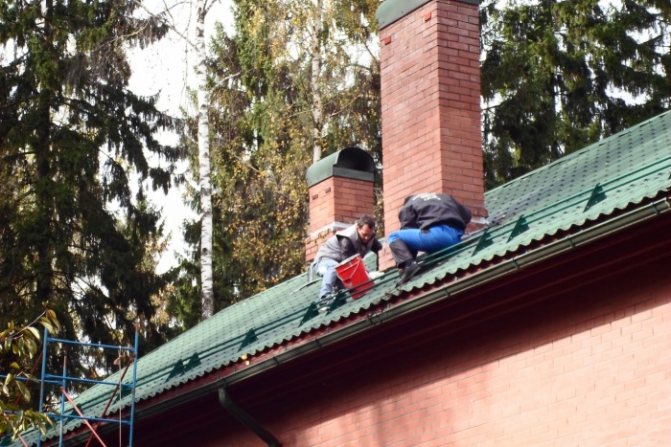

How is it applied
The pipe and roof surface to which the tape is glued must be cleaned and dried. It is important that the area to be treated is level. To apply the tape, you need to cut a piece of a certain length, then remove the protective film and press the product tightly to the joint (gap). At temperatures below +5, the tape is first kept indoors at a temperature of 15 degrees for 12 hours.
The use of the tape in subzero temperatures involves heating the surface to be treated. The tape is not used for surfaces with a working temperature above 80 degrees or when the roof slope is more than 55 degrees.
Location of the abutment
In the SNiP regulations concerning the arrangement of chimneys, there is no clear regulation of the location of the chimney pipe.
We suggest that you familiarize yourself with: How to insulate a chimney pipe in the ceiling
- the chimney should rise above the ridge by at least 50 cm if the pipe itself is located at a distance of up to 150 cm from it;
- if the chimney is located at a distance of 150-300 cm from the ridge, then its height can be equal to or higher than the level of the ridge;
- if the chimney is located more than 300 cm from the ridge, then the pipe on the chimney is placed at a level with the ridge or not below the line that is drawn from the ridge at an angle of 10 degrees relative to the horizon.
Condensation can form inside the pipe or on the inner surface of the protective umbrella. The main danger of the resulting moisture is that at low temperatures it forms ice, which negatively affects traction. In addition, condensate flows down into the walls of the chimney, thereby contributing to the development of corrosion processes and reducing the period of operation of the chimney.
- in this place it is much easier to organize the abutment of the pipe to the roof;
- Due to the small slope area above the pipe, the formation of snow pockets, which lead to leaks, is minimized.
Sealing the gap
The traditional method of sealing the gap between the pipe and the roof involves an apron. For its construction, you will need abutment strips. They are placed at the bottom of the chimney pipe.They are applied to the pipe and marks are made on the top.
The grinder is used to perform the strobe. Subsequently, the remaining parts of the apron are overlapped around the pipe. The edges of the strip inserted into the groove must be covered with a heat-resistant sealant. The lower parts of the plank are trimmed and fastened with self-tapping screws. The gap between the pipe and the roof is sealed in such a way that water flows into the gutters.
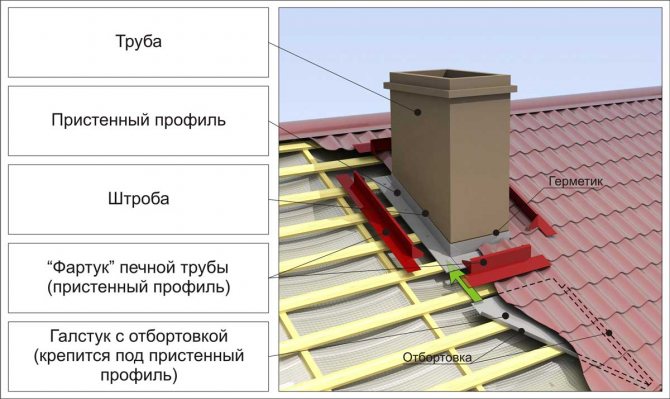

A roofing part is mounted on top of the laid elements, and an external tie is constructed around the pipe. When setting it, it is important to take into account the inner tie pattern. The upper strips are not inserted into the groove, they are simply adjacent to the pipe.
If the pipe has a round shape, a special nozzle can be used. It is also used to seal antennas and ventilation outlets. It looks like a stepped pyramid. If the nozzle is rubber, it can be used in a temperature range from -50 to +130 degrees. Silicone models have a wider range - from -70 to +250 degrees.
There should be a distance of 25 cm from the chimney to the structures protected from fire. In the case of unprotected elements, it should not be less than 35 cm. The ideal option is to create an air gap. However, such a solution causes a large heat loss, which is disadvantageous from the point of view of thermal insulation.


Round pipe on slate
When the pipe is located close to the ridge, it is closed in the following sequence:
- One of the steel sheets, with which the ridge is formed, is lowered down to the overlap of the pipe section.
- A round cut is made in the sheet for the pipe with a flanging of its edge two centimeters up.
- An asbestos-cement ring is put on the pipe.
- To fix the ring along the height of the pipe, insert a pin into its side hole.
- The ring is set parallel to the ramp using a wedge.
- The edges of the cut in the steel sheet are led inside the ring.
- The joint is covered with a mixture of cement and fluffed asbestos (1: 2).
This method is excellent for protecting the roof from rain, but snow accumulates in the gap between the slate and the pipe. You can find out about the tightness of the chimney roof.
In order for the pipe and slate to join hermetically, do the following:
- A cardboard cylinder wrapped in plastic wrap is inserted into the gap between the slate and the pipe.
- A clay or plasticine border is formed on a steel sheet. The distance between the flange and the cardboard cylinder should not be more than 10 mm.
- The resulting gap is filled with an asbestos-cement mixture.
- After the mixture has hardened, the cylinder with the restrictive rim is removed;
- An asbestos ring is put on the pipe (see above).
Is the roof leaking or the chimney leaking?
Before starting work, it is important identify the nature of the leak:
- The roof leaks near the chimney. The pipe passage assembly is leaking, but the chimney is free from defects. Needed repair of the problematic area of the roof.
- The chimney is flowing. The cause of the leak is the destruction of the pipe and damage to the weather vane. The situation is typical for brick chimneys. Required pipe restoration, masonry and plastering works. If the masonry is made of low grade bricks, it is recommended to insulate and sheathe the chimney to protect it from the effects of the environment.
Related article: What materials are used for roofing roofs

